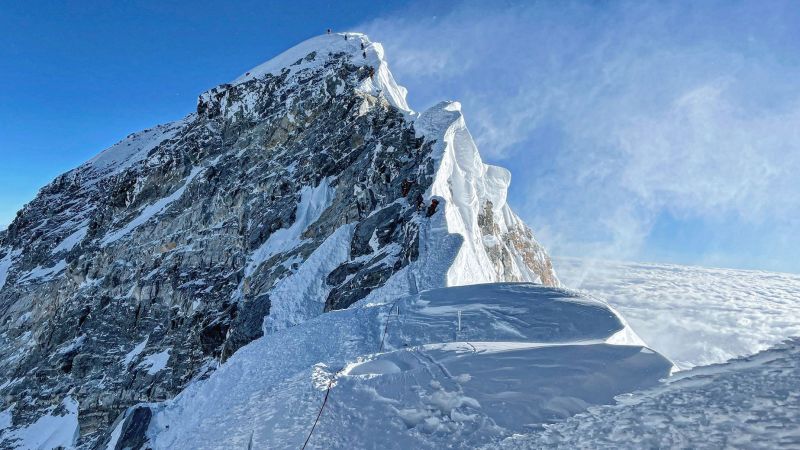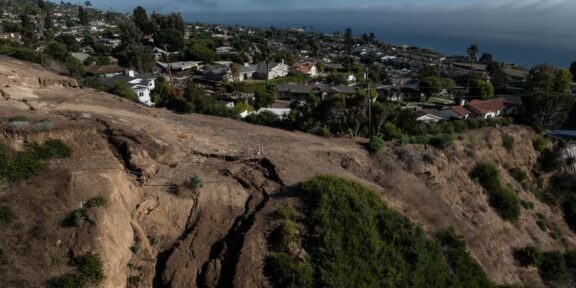CNN
—
Thick murky clouds fill the sky, with freezing winds carrying snow sooner than 100 miles per hour. With a frigid –30 levels Fahrenheit temperature, life-threatening snowstorms and avalanches are frequent.
And these are typical circumstances on the world’s highest mountain: Mount Everest.
The behemoth towers 29,032 toes (8,849 meters) between Nepal and Tibet within the Himalayas, with its peak surpassing most clouds within the sky.
An try and climb Everest requires months, typically years, of coaching and conditioning – even then, reaching the summit is much from assured. The truth is, greater than 300 persons are recognized to have died on the mountain.
And but the mountain nonetheless attracts a whole bunch of climbers who’re decided to succeed in its peak each spring. Right here’s what it takes to make the climb and what has motivated some climbers to summit the world’s highest peak.
Dr. Jacob Weasel, a trauma surgeon, efficiently summited Everest final Could after conditioning for almost a 12 months.
“I’d placed on a 50-pound backpack and do two hours on a stair stepper with no drawback,” Weasel informed CNN. “So, I believed that I used to be in fairly fine condition.” Nevertheless, the surgeon stated he was humbled after discovering that his health was no match for the lofty athleticism required by the mountain.
“I’d take 5 steps and must take 30 seconds to a minute to catch my breath,” Weasel recalled of his battle with the shortage of oxygen accessible whereas ascending Everest.
Climbers aiming for the summit normally observe an acclimatizing rotation to regulate their lungs to the thinning oxygen ranges as soon as they arrive on the mountain. This course of entails mountaineers touring upward to one of many 4 designated camps on Everest and spending one to 4 days there earlier than touring again down.
This routine is repeated not less than two instances to permit the physique to adapt to declining oxygen ranges. It will increase a climber’s probabilities of survival and summiting.
“In case you took someone and simply plopped them up on the excessive camp on Everest, not even on the (high), they might in all probability go right into a coma inside 10 to fifteen minutes,” Weasel stated.
“And they’d be lifeless inside an hour as a result of their physique isn’t adjusted to that low of oxygen ranges.”
Whereas Weasel has efficiently summited dozens of mountains, together with Kilimanjaro (19,341 ft), Chimborazo (20, 549 ft), Cotopaxi (19,347 ft), and most just lately Aconcagua (22,837 ft) in January, he stated none of them compares to the high-altitude of Mount Everest.
“As a result of regardless of how effectively you might be educated, when you get to the bounds of what the human physique can take, it’s simply tough,” he continued.
At its highest altitude, Everest is almost incapable of sustaining human life and most mountaineers use supplementary oxygen above 23,000 toes. The dearth of oxygen poses certainly one of best threats to climbers who try and summit, with ranges dropping to lower than 40% after they attain the Everest “loss of life zone.”

The primary goal for mountaineers is Everest base camp at roughly 17,000 toes, which takes climbers about two weeks. Then they ascend to the three remaining camps stationed alongside the mountain.
Camp 4, the ultimate one earlier than the summit, sits alongside the sting of the loss of life zone at 26,000 toes, exposing climbers to a particularly skinny layer of air, subzero temperatures, and excessive winds highly effective sufficient to blow an individual off the mountain.
“It’s tough to outlive up there,” Weasel informed CNN. He remembers passing our bodies of climbers who died on the mountain – which isn’t unusual. The our bodies of the fallen mountaineers are well-preserved, exhibiting little to no decay because of the intense chilly temperatures.
“I’m in all probability extra conversant in loss of life and the lack of life than most individuals,” the surgeon stated. “For me it was only a reminder of the gravity of the state of affairs and the fragility of what life is… much more so motivation for appreciating the chance.”
Excessive-altitude cerebral edema (HACE) is without doubt one of the most typical sicknesses climbers face whereas trying to summit. “Your mind is starved of oxygen,” Weasel stated.
HACE ends in the mind swelling throughout its try and regain secure oxygen ranges, inflicting drowsiness, bother talking and considering. This confusion is commonly accompanied by blurred imaginative and prescient and sporadic episodes of delusion.
“I had auditory hallucinations the place I used to be listening to voices [of friends] that I believed have been coming from behind me,” Weasel recalled. “And I had visible hallucinations,” he added. “I used to be seeing the faces of my youngsters and my spouse popping out of the rocks.”
Weasel recalled crossing paths with a good friend, Orianne Aymard, who was trapped on the mountain as a result of an damage. “I keep in mind gazing her for like 5 minutes and simply saying, ‘I’m so sorry,’” Weasel stated.
“I’ve spent over a decade of my life coaching to assist individuals as a surgeon, and being ready the place there’s someone who requires your assist and you might be unable to supply any help… that feeling of helplessness was robust to cope with,” Weasel informed CNN.
Aymard survived. She was rescued and suffered from a number of damaged bones in her foot, along with extreme frostbite on her arms. Regardless of all her accidents, Aymard is taken into account one of many fortunate ones.

Everest has lengthy been a tomb for climbers who’ve succumbed to harsh circumstances or accidents on its slopes.
When a cherished one or fellow climber is severely injured or dies on the mountain, it’s routine to depart them behind when you’re unable to avoid wasting them, based on Alan Arnette, a mountaineer coach who summited Everest in 2014.
“What most groups do out of respect for that climber, they are going to transfer the physique out of sight,” he stated. And that’s provided that they’ll.
“Generally that’s simply not sensible due to the unhealthy climate, or as a result of their our bodies will get frozen into the mountain,” Arnette informed CNN. “So, it’s very tough to maneuver them.”
Seeing a corpse on Everest is akin to seeing a horrible automotive accident, based on the mountain coach. “You don’t flip round and go house,” Arnette stated. “You respectfully decelerate… or say a prayer for that individual, and then you definitely proceed.”
It’s been 10 years since the one deadliest accident on the world’s highest mountain, after an avalanche killed 12 Sherpa guides. And 2023 was recorded because the deadliest 12 months on Everest, with 18 fatalities on the mountain – together with 5 individuals which can be nonetheless unaccounted for.
The technique of recovering our bodies is intensive, typically unimaginable. Helicopter rescues and search missions are difficult because of the excessive altitude and often treacherous circumstances, leading to some rescuers dying of their try to avoid wasting others.

The three,000 toes climb from camp 4 to the summit can take wherever from 14 to 18 hours. Subsequently, mountaineers sometimes go away the camp at evening.
“That complete evening was chilly,” Weasel recalled. “It’s darkish, it’s windy.” Nevertheless it was confirmed to be value it within the morning, he stated.
“Watching the dawn from 29,000 toes and having that pyramid of Everest’s shadow projected onto the valley under you…,” Weasel informed CNN. “It was in all probability one of the crucial lovely issues I’ve ever seen in my life,” he continued.
“It’s bizarre standing up there and realizing that every little thing else on the planet is under the place you’re standing.”
The scale of the mountain is humbling, the surgeon stated. “I’ve by no means felt so small,” he recalled. “That combination of humility and connectedness with one thing greater than your self is the correct place from which we should method our existence on this planet.”
Like Weasel, Arnette summited at dawn, and skilled this similar feeling of “smallness.” On the high there have been “extra mountains than you’ll be able to rely,” Arnette remembered. “It was a way of huge gratitude and on the similar time I knew I needed to get again down.”
After about 20 minutes to an hour, climbers sometimes begin to descend again to the bottom of the mountain.

Earlier than leaving for Nepal, Weasel was gifted an eagle’s feather as a beacon for his Native American heritage. He was decided to plant the feather “on the highest of the world as an emblem of our individuals and what we’ve endured for the previous a number of hundred years,” Weasel informed CNN. “Exhibiting that our spirit isn’t damaged, however we’re in a position to rise above the issues which have occurred to us,” he continued.
And this is the reason he determined to summit Everest, to be an instance that something is feasible for younger Native individuals and his tribe.
“Understanding what it’s like up there, for me personally, the one actual justification for going and placing your life, and different lives, in danger is when you’re climbing for a cause that’s a lot greater than you,” stated Weasel.
Arnette tried to climb Everest 3 times earlier than he efficiently summited.
“My first three tries, I wasn’t clear on my why,” Arnette stated. When his mom was identified with Alzheimer’s illness, he checked out his objective for climbing in a different way.
“I needed to do it to boost cash for Alzheimer’s and honor my mom,” Arnette stated.
There are roughly 300 individuals which were issued a allow from the Nepal authorities to climb the mountain this 12 months, based on Arnette. And he stated the quantity is down from earlier years. [working to confirm the number of permits issued]
“I feel one of many causes is as a result of we had the 18 deaths final 12 months, and other people notice that Mount Everest is a harmful mountain.”
Nevertheless, he doesn’t consider that ought to deter climbers from trying to summit. “I’m an enormous believer that while you go climb these mountains that you just come house a greater model of your self,” Arnette informed CNN.
“Everest has turn out to be too commercialized with ‘you’re stepping over lifeless our bodies’ and ‘it’s affected by trash,’” the mountain coach stated. “The fact is that it’s a very small diploma all of that, however there’s plenty of pleasure that individuals get out of doing it,” he continued.
“And that’s the explanation that we climb mountains.”











